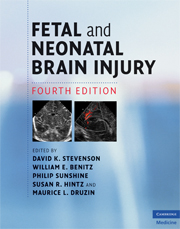Book contents
- Frontmatter
- Contents
- List of contributors
- Foreword
- Preface
- Section 1 Epidemiology, pathophysiology, and pathogenesis of fetal and neonatal brain injury
- Section 2 Pregnancy, labor, and delivery complications causing brain injury
- Section 3 Diagnosis of the infant with brain injury
- Section 4 Specific conditions associated with fetal and neonatal brain injury
- 22 Congenital malformations of the brain
- 23 Neurogenetic disorders of the brain
- 24 Hemorrhagic lesions of the central nervous system
- 25 Neonatal stroke
- 26 Hypoglycemia in the neonate
- 27 Hyperbilirubinemia and kernicterus
- 28 Polycythemia and fetal–maternal bleeding
- 29 Hydrops fetalis
- 30 Bacterial sepsis in the neonate
- 31 Neonatal bacterial meningitis
- 32 Neurological sequelae of congenital perinatal infection
- 33 Perinatal human immunodeficiency virus infection
- 34 Inborn errors of metabolism with features of hypoxic–ischemic encephalopathy
- 35 Acidosis and alkalosis
- 36 Meconium staining and the meconium aspiration syndrome
- 37 Persistent pulmonary hypertension of the newborn
- 38 Pediatric cardiac surgery: relevance to fetal and neonatal brain injury
- Section 5 Management of the depressed or neurologically dysfunctional neonate
- Section 6 Assessing outcome of the brain-injured infant
- Index
- Plate section
- References
26 - Hypoglycemia in the neonate
from Section 4 - Specific conditions associated with fetal and neonatal brain injury
Published online by Cambridge University Press: 12 January 2010
- Frontmatter
- Contents
- List of contributors
- Foreword
- Preface
- Section 1 Epidemiology, pathophysiology, and pathogenesis of fetal and neonatal brain injury
- Section 2 Pregnancy, labor, and delivery complications causing brain injury
- Section 3 Diagnosis of the infant with brain injury
- Section 4 Specific conditions associated with fetal and neonatal brain injury
- 22 Congenital malformations of the brain
- 23 Neurogenetic disorders of the brain
- 24 Hemorrhagic lesions of the central nervous system
- 25 Neonatal stroke
- 26 Hypoglycemia in the neonate
- 27 Hyperbilirubinemia and kernicterus
- 28 Polycythemia and fetal–maternal bleeding
- 29 Hydrops fetalis
- 30 Bacterial sepsis in the neonate
- 31 Neonatal bacterial meningitis
- 32 Neurological sequelae of congenital perinatal infection
- 33 Perinatal human immunodeficiency virus infection
- 34 Inborn errors of metabolism with features of hypoxic–ischemic encephalopathy
- 35 Acidosis and alkalosis
- 36 Meconium staining and the meconium aspiration syndrome
- 37 Persistent pulmonary hypertension of the newborn
- 38 Pediatric cardiac surgery: relevance to fetal and neonatal brain injury
- Section 5 Management of the depressed or neurologically dysfunctional neonate
- Section 6 Assessing outcome of the brain-injured infant
- Index
- Plate section
- References
Summary
Introduction
The mammalian fetus, in utero, is entirely dependent upon the mother for a continuous supply of glucose and other nutrients. Data from a number of studies in humans and animals have shown that under physiological circumstances there is no measurable production of glucose by the fetus, and that the entire glucose pool in the fetal compartment is derived from the mother. The transition from the intrauterine environment to an independent extrauterine life is associated with a number of metabolic and hormonal responses, which allow the vast majority of neonates to adapt to the extrauterine environment without any problem. Among the key events involved in this adaptation is the initiation of systemic glucose production, both from glycogenolysis and gluconeogenesis, in the period immediately after birth. Failure to adapt, as a consequence of alterations in maternal metabolism such as in diabetes in pregnancy, or as a consequence of metabolic problems in the neonate, may result in perturbations in glucose homeostasis leading to low blood glucose concentrations or hypoglycemia. It should be underscored that, during the initial period after birth, there is a decline in plasma glucose concentration from the cord blood levels in all infants, followed by an increase to a steady-state concentration. Although in the majority of infants this decrease in blood glucose concentration may be transient and inconsequential, in others it may be profound or persistent and lead to clinically serious problems involving significant neurological injury.
- Type
- Chapter
- Information
- Fetal and Neonatal Brain Injury , pp. 304 - 310Publisher: Cambridge University PressPrint publication year: 2009



